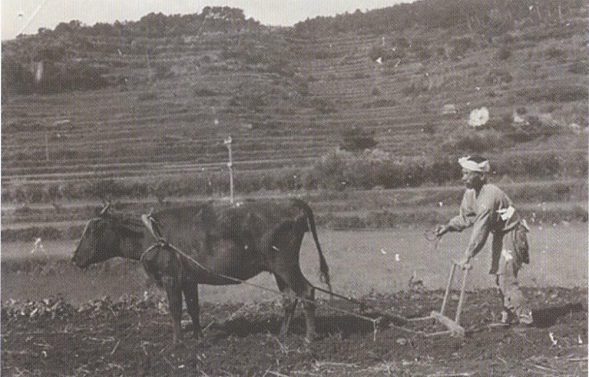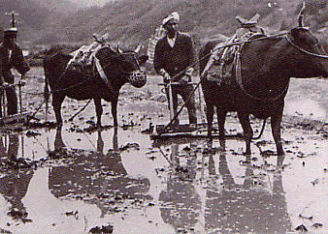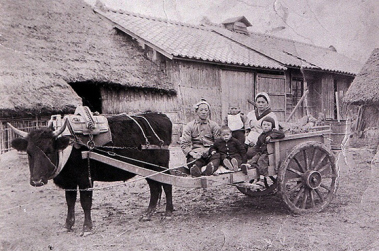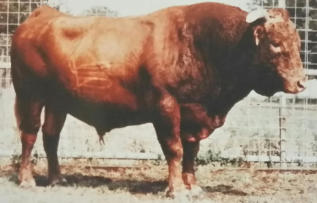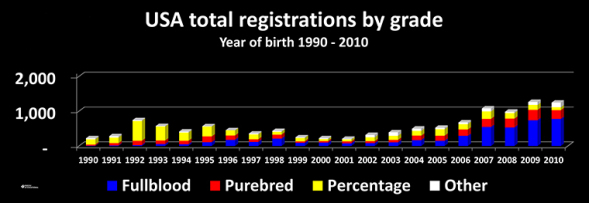

Chronicle of Breed
The word Wagyu refers to all Japanese beef cattle ('Wa' means Japanese or japanese-style and 'gyu' means cattle).
Most of the cattle were influenced by British and Continental breeds for a few generations nearly 100 years ago. Brown Swiss, Shorthorn, Devon, Simmental, Ayrshire, Korean, Holstein and Angus had been imported by 1887 and impacted today's Wagyu.
Crossbreeding was prominent for several years, but when the price of crossbreds collapsed in 1910 no further crossbreeding was conducted. The result was selection for specific traits determined by region and extensive linebreeding was used to achieve those traits.
There are four main meat-producing breeds of Japanese Cattle (和牛 - “Wagyu”):
Japanese Black (黒毛和種 / Kurogewashu) - they are monochromatic black tinged with brown, and often pale under the body and inside the legs. These account for over 80% of cattle in Japan.
Japanese Brown (褐毛和種 / Akagewashu) - of a more tan monocromatic color, these are slighly larger than the Japanese Black.
Japanese Shorthorn (日本短角種 / Nihon Tankakushu) - these are a dark reddish brown and account for only 1 to 2% of cows in Japan.
Japanese Polled (無角和種 / Mukaku Washu) - small black colored with black hoofs; not even 1% of cattle in Japan.
The dominant black Wagyu strains are Tottori (Kedaka), Tajima, Shimane, and Okayama. Tajima cattle, bred in the Tajima region, were originally chosen and bred for their heavy forequarters because their primary use was to pull carts. They tend to be smaller and less heavily muscled than the Tottori (Kedaka) breed. Tottori cattle, because they were used as pack animals for the grain industry of the Tottori region, were selected for their size and strength of topline.
The other main "breed" of Wagyu, was developed on the island of Kyushu and are red in color. As with the blacks, there are two distinct strains-Kochi and Kumamoto. Kochi cattle were strongly influenced by Korean breeding while Kumamoto are believed to have considerable Simmental influence.
The original import of these cattle to the U.S. in 1976 consisted of two Tottori Black Wagyu and two Kumamoto Red Wagyu bulls. That was the only importation of Wagyu into the U.S. until 1993 when two male and three female Tajima cattle were imported and 1994 when 35 male and female cattle consisting of both red and black genetics reached the U.S.
Chronicle
- Domesticated Cattle arrives in Japan around 400 BC.
- Scrolls from the Heian Period (794-1185) show lavishly decorated ox pulling nobles in carriages
- Cattle were improved for farming use and people began to eat meat after the Meiji Period (1868).
- A survey in 1887 said there was 1.07 million head of cattle
- 1912 Importing foreign breeds is banned. Improvements performed on Japanese Black breed to increase body weight, meat quality and fertility.
- 1944, Wagyu approved as a fixed breed by Japanese government
- 1955 – 1965 Fattening method similar to current method is refined
- In 1976, four bulls were sent from Japan to Colorado University in the USA. This importation was arranged by Mr. Morris Whitney. The consignment consisted of two Brown Wagyu bulls (Red Wagyu and that is how they are still known today in the Western World) and two Black Wagyu bulls. The bulls eventually finished up with two farmers, Don Lively and Fred Hildebrand. These cattle become known as American Purebred because no 100% Wagyu females were available to breed with these bulls.
-
Along with Texas A&M University, Washington State University was also researching Wagyu. In 1993 a group of people including a lecturer at Washington State, a Korean, and a Japanese American who later become known as the ‘Mannett Group’ imported from Japan three black Wagyu females and two black Wagyu bulls.
This was closely followed by a group headed by a US senator called JVP (Japanese Venture Partners) imported ten black Wagyu females and three black Wagyu bulls. Mannett Group then imported another four black females, two red females and two black bulls. Also about this time a group headed by Dr. Al and Marie Wood trading as ‘Heartbrand’ imported seven red Wagyu females and three red Wagyu bulls.
In 1994, one of Japan’s premier and prominent breeders Mr. Shogo Takeda built on his own property a quarantine centre that was approved by USDA to ship cattle from Japan to the USA. Consequently 35 black Wagyu females and five black Wagyu bulls were shipped. Some of the females were already pregnant before leaving Japan and another eight female calves were added to the herd.
In 1996, Mr. Takeda exported another 45 females and six bulls to the USA. Mr. Takeda has since sold all his cattle in the USA to Mr. Gary Yamamoto, an American Japanese famous for professional competition fisherman.
Also at this time another group headed up by Mr. Chris Walker called ‘Westholme Wagyu’ and working with Mr. Daiji Imori of ET Japan exported to the US from Japan three black Wagyu bulls and 25 black Wagyu females. These cattle had some embryos collected from them in the USA and exported to Australia. The partnership between ET Japan and Westholme Wagyu was dissolved and the females were then shipped to Australia. The bulls remain in the USA.
-
The number of Wagyu registrations by grade by year of birth by the American Wagyu Association is illustrated (from American Wagyu Association):It was estimated in 2006 that there were 24,000 Wagyu-crosses on feed at any time out of 10 to 12 million cattle in total in USA feedlots.Registration information is available from the American Wagyu Association website
References:
1. Steve Bennett Wagyu International
2. David Blackmore Blackmore Wagyu
3. American Wagyu Association
4. Oklahoma State University Department of Animal Science
5. Texas A&M University
6. Washington State University
7. Oshu City Cattle Museum Japan
8. Yamaguchi Prefecture Agriculture and Forestry Technology Center Japan
Contact Details
Midwest Wagyu
1315 Winningham
Seymour, Missouri 65746
Phone: +1 417 664-9770+1 417 664-9770
Email: contact@midwestwagyu.com
What's Fresh?
Currently we are flushing to the following bulls: Mazda, 005 Shigefuku J1822, JVP Kikuyasu 400, Beijiro, Mt Fuji out of cows including Mazda daughters, Genjiro, Michifuku, Genesis in the blacks.

